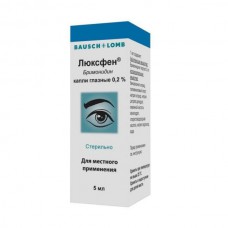Expiration date: 03/2026
Pharmacological action
Antiglaucoma drug. The Brimonidine — selective agonist of ?2-adrenergic receptors.
When instillation of 0.2% solution brimonidine reducing the intraocular pressure of 10-12 mm Hg. article, the maximum effect observed after 2 h, the duration of 12 h
The Brimonidine has a dual mechanism of action: reduces intraocular pressure by reducing synthesis of aqueous humor and enhancing uveoscleral outflow.
Pharmacokinetics
Absorption and distribution
When instillation of eye drops Cmax of the drug in plasma achieved through 0.5-2.5 hours Linking blood protein to the local application of 29%. Systemic absorption Brimonidine slow. After application of the drug 2 times/day for 10 days brimonidine concentration in plasma remains low (average 0.06 ng/ml).
Metabolism and distribution
The drug is metabolized mainly in the liver. The Brimonidine and its metabolites are excreted by the kidneys. T1/2 is about 2 h.
Testimony
Open-angle glaucoma and ocular hypertension (as monotherapy and in combination with other drugs that reduce intraocular pressure).
Contraindications
- Hypersensitivity to the drug component
- concurrent therapy with monoamine oxidase inhibitors (MAOIS) and tricyclic antidepressants,
- children up to age 2 years,
- the lactation period.
Caution: when using the drug in patients with severe, unstable or uncontrolled form of cardiovascular disease, cerebral or coronary insufficiency, depression, orthostatic hypotension, Raynaud's disease, thromboangiitis obliterans, when violation of the liver or kidneys, children's age from 2 to 18 years.
Application of pregnancy and breastfeeding
Studies on the safety and effectiveness of brimonidine in pregnant and nursing was conducted. In animal studies the topical application Brimonidine not lead to disruption of fetal development. There are no accurate data on the penetration of breast milk Brimonidine the local application. However, the risk cannot be eliminated completely. Application Brimonidine during pregnancy is allowed only in cases when expected benefit for mother exceeds potential risk for fetus or child.
In the appointment during lactation breastfeeding should stop at the time of treatment.
Special instructions
Before use of the drug should remove contact lenses. The time interval between use of the drug and re-installation of the contact lens must be at least 15 min.
Effects on ability to drive vehicles and other mechanisms that require high concentration
The drug may cause fatigue or drowsiness, reduction of visual acuity, so the period of treatment should refrain from driving vehicles and maintenance of moving mechanisms.
Composition
1 ml eye drops contains:
Active substance: brimonidine tartrate – 2,0 mg.
Excipients: benzalkonium chloride (in recalculation on 100% substance) – 0,052 mg, polyvinyl alcohol – 14.0 mg, sodium chloride – of 6.90 mg, sodium citrate dihydrate – 4,70 mg, citric acid monohydrate – 0,48 mg, hydrochloric acid to a pH of 6.45, sodium hydroxide to a pH of 6.45, water up to 1 ml.
Method of application and doses
Local.
Instill 1 drop of the drug 2 times a day.
The duration of treatment determined by the doctor.
Side effects
The incidence of side effects is classified as follows:
very often (>,1/10),
often (from the > 1/100 to <, 1/10),
sometimes (from the > 1/1000 to, 1/100),
rare (from the > 1/10, 000 to <, 1/1000),
very rare ( <, 1/10 000),
unknown frequency (side effects with unknown frequency).
From the side of organs of vision: often - conjunctivitis allergic, conjunctival hyperemia, itching of the eyelid skin and mucous membranes of the eyes, often burning sensation, follicules eye conjunctiva, and a follicular conjunctivitis include allergic reactions of the mucous membrane of the eye (including keratoconjunctivitis sicca), blepharitis, blepharoconjunctivitis, violation of clarity of vision, cataracts, swelling of the conjunctiva, bleeding in the conjunctiva, conjunctivitis, watery eyes, mucous discharge from the eyes, dryness and irritation of the mucous membranes of the eyes, pain, swelling of the eyelids, redness of the eyelids, foreign body sensation in eyes, keratitis, eyelid, photosensitivity, surface spotted keratopathy, lacrimation, loss of sight, functional damage of the vitreous body, bleeding in the vitreous body, floating opacities in the vitreous and decreased visual acuity, rarely, erosion of the cornea, barley.
From the Central nervous system: often - headache, drowsiness, insomnia, dizziness.
Of the cardiovascular system: often- increased blood pressure, rarely - lowering blood pressure.
From the side of respiratory system: often - bronchitis, cough, shortness of breath, rarely, dryness of the mucous membrane of the nose, apnea.
The gastro-intestinal tract: often - gastrointestinal disorders - dyspepsia, dry mucous membranes of the mouth.
The skin and subcutaneous fat: often - rash.
Infectious and parasitic diseases: often – grippopodobnyy syndrome, infectious disease (fever and respiratory infection), rhinitis, sinusitis, including an infection.
The laboratory parameters: often — hypercholesterolemia.
Other: often - General allergic reaction, asthenia, fatigue, rarely - change in taste.
The children observed: apnea, bradycardia, decreased blood pressure, hypothermia, muscular hypotonia.
Additionally, the data obtained about the following effects:
From the side of organs of vision: frequency unknown - iritis, keratoconjunctivitis sicca, miosis.
From the Central nervous system: depression.
From the side of cardiovascular system: bradycardia, tachycardia.
The gastro-intestinal tract: nausea.
The skin and subcutaneous fat: local skin reactions (erythema, pruritus, swelling face, rash, and vasodilation of blood vessels of the eyelid skin).
Drug interactions
The Brimonidine at a concentration of 2 mg/ml may increase the effects of substances that affect the Central nervous system (alcohol, barbiturates, opioids, sedatives, and anesthetics). Caution should be exercised when taking medications that can affect absorption into the blood and the metabolism of adrenaline, noradrenaline and other so-called biogenic amines (chlorpromazine, methylphenidate, reserpine).
Some patients after application of the solution Brimonidine at a concentration of 2 mg/ml has been a slight decrease in blood pressure. Caution should be exercised when coadministration with antihypertensive drugs and/or drug groups of cardiac glycosides (digitalis).
With simultaneous systemic administration of agonists or antagonists of adrenergic (eg, isoprenaline or prazosin) for the first time and when changing the dose of these at the same time introduce a system of drugs (regardless of the method of their introduction), there may be interaction with agonists alpha-adrenergic effects on their effects.
Overdose
Overdose is rarely observed.
Symptoms: at random the admission into possible drug - Central nervous system depression, drowsiness, depression and loss of consciousness, decreased blood pressure, bradycardia, decreased body temperature, cyanosis of the skin, apnea.
Treatment: supportive symptomatic therapy, control of the airway.


